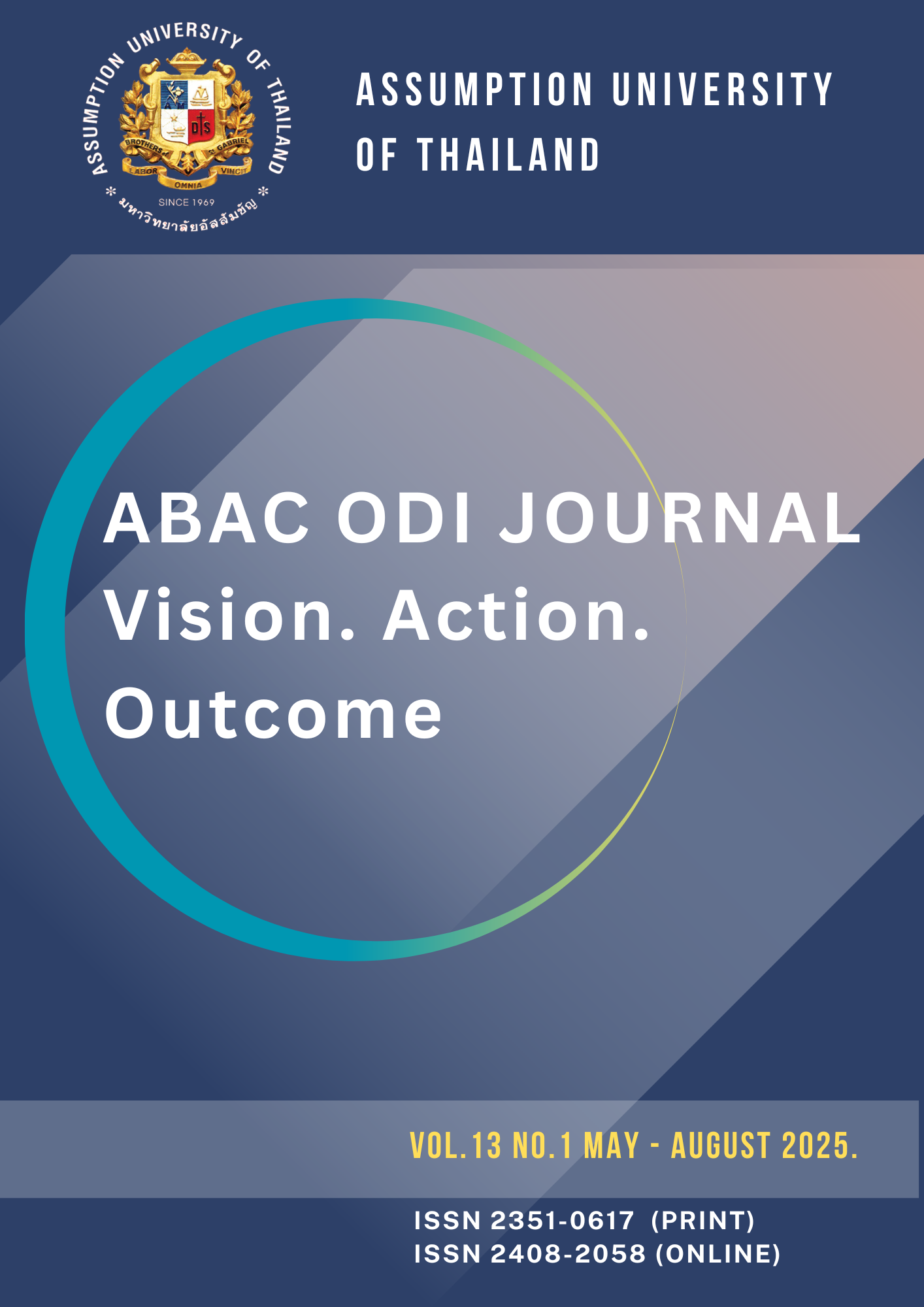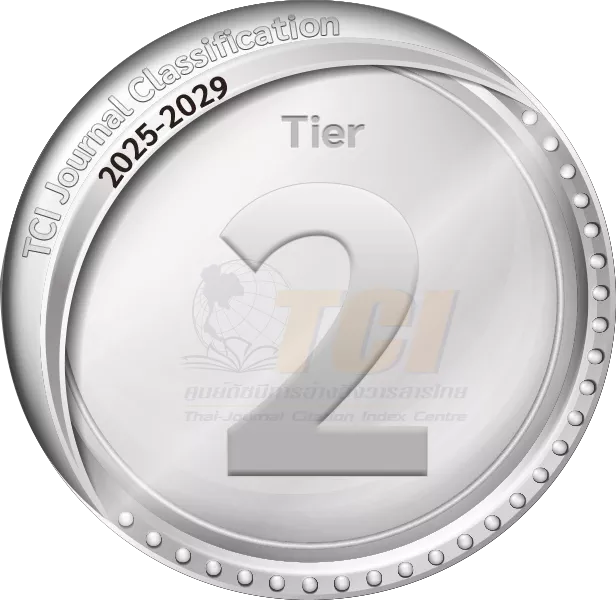Reducing the Intergenerational Gap between Senior and Younger Employees through OD Interventions on Communication, Leadership, Work Values and Knowledge Management: An Action Research at a Thai Workplace
DOI:
https://doi.org/10.14456/abacodijournal.2025.22Abstract
The perception of an intergenerational gap between the senior and younger employees spawns hurdles and difficulties in many workplaces, including an air cargo company based in Bangkok, Thailand. According to the initial assessment results, it was most apparent in the areas of communication, leadership, work values (WVs), and knowledge management (KM). This study reviewed literature on intergenerational gap and the identified issues, designed organization development interventions (ODIs), and implemented them to address the problems. The study was carried out among 40 full-time staff, representing several departments and two major generations at the company. The ODIs took the form of introduction to relevant OD workshops, activities, discussions using appreciative inquiry process. Participants’ attitudes and opinions were measured in the five areas before and after the ODIs using quantitative and qualitative designs. Following the ODIs, paired samples t-tests and focus group results showed that the perceived intergenerational gap and the four key issues were significantly reduced. MLR post-ODI demonstrated that communication had a significant relationship with intergenerational gap. However, other variables showed no significant relationship. This may be due to the confounding factors in the quasi-experiment or limited sample size. The study suggested that companies who employed several generations at workplaces could use the ODI in this study as a starting point for generation gap bridging discussion and improvement in terms of communication, leadership styles, WVs, and KM. It also serves as a basis for revisiting intergenerational debate from the Thai cultural context, which differ from the context in which most generational theories originated. Future studies could focus on validating the models that emerged from that debate.
References
Appelbaum, S. H., Bhardwaj, A., Goodyear, M., Gong, T., Sudha, A. B., & Wei, P. (2022). A Study of Generational Conflicts in the Workplace. European Journal of Business and Management Research, 7(2), 7-15.
https://www.ejbmr.org/index.php/ejbmr/article/view/1311
Baltes, P. B. (1987). Theoretical propositions of life-span developmental psychology: On the dynamics between growth and decline. Developmental Psychology, 23, 611-626. https://doi:10.1037/0012-1649.23.5.611
Berge, Z. L., & Berge, M. B. (2019). The economic ABCs of educating and training generations x, y, and z. Performance Improvement, 58(5), 44-53.
http://dx.doi.org/10.1002/pfi.21864
Berlo, D. K. (1960). The process of communication. Holt, Rinehart and Winston. https://archive.org/details/dli.ernet.235577
Blanchard, K. H., Zigarmi, D., & Nelson, R. B. (1993). Situational leadership® after 25 years: A retrospective. Journal of Leadership Studies, 1(1), 21-36.
https://doi.org/10.1177/107179199300100104
Blanchard, K. H., Zigarmi, P., & Zigarmi, D. (1985). Leadership and the one minute manager: Increasing effectiveness through situational leadership. William Morrow. https://beststpbstucourse.wordpress.com/wp-content/uploads/2017/03/ leadership_and_the_one_minute_manager-kenneth-blanchard.pdf
Boyle, K. A. (2021). Millennial Career-identities: Reevaluating Social Identification and Intergenerational Relations. Journal of Intergenerational Relationships, 89-109. https://doi.org/10.1080/15350770.2021.1945989
Campbell, S. M., Twenge, J. M., & Campbell, K. (2017). Fuzzy But Useful Constructs: Making Sense of the Differences Between Generations. Work, Aging and Retirement, 3(2), 130-139. https://doi.org/10.1093/workar/wax001
Chatman, J. A. (1989). Improving Interactional Organizational Research: A Model of Person-Organization Fit. Academy of Management Review, 14(3).
https://journals.aom.org/doi/abs/10.5465/AMR.1989.4279063
Costanza, D. P., Badger, J. M., Fraser, R. L., Severt, J. B., & Gade, P. A. (2012). Generational differences in work-related attitudes: A meta-analysis. Journal of Business and Psychology, 27, 375-394. https://link.springer.com/article/10.1007/s10869-012-9259-4
Costanza, D. P., Rudolph, C. W., & Zacher, H. (2023). Are generations a useful concept?. Acta Psychologica, 241. http://dx.doi.org/10.1016/j.actpsy.2023.104059
Downs, H. (2019). Bridging the Gap: How the Generations Communicate. Concordia Journal of Communication Research, 6(6), 1-23.
https://digitalcommons.csp.edu/cgi/viewcontent.cgi?article=1027&context=comjournal
Farrell, W. C., & Phungsoonthorn, T. (2020). Generation Z in Thailand. International Journal of Cross-Cultural Management, 20(1), 25-51.
https://doi.org/10.1177/1470595820904116
Fiedler, F. (1967). A theory of leadership effectiveness. McGraw-Hill
https://archive.org/details/theoryofleadersh00fied
Fratrièová, J., & Kirchmayer, Z. (2018). Barriers to work motivation of generation Z. Journal of human resource management, 21(2), 28-39.
https://www.researchgate.net/publication/329145147_Barriers_to_work_motivation_of_Generation_Z
Geier, J. G. (1990). The personal profile system: A plan to understand self and others. Performax Systems.
Hillman, D. R. (2014). Understanding multigenerational work-value conflict resolution. Journal of Workplace Behavioral Health, 29(3), 240-257.
https://doi.org/10.1080/15555240.2014.933961
Kapoor, C., & Solomon, N. (2011). Understanding and managing generational differences in the workplace. Worldwide Hospitality and Tourism Themes, 3(4), 308-318.
https://doi.org/10.1108/17554211111162435
Kincaid, D. L. (1979). The convergence model of communication. The East-West Communication Institute, Honolulu.
Kincaid, D. L. (1987). Communication Theory; Eastern and Western Perspectives. Academic Press. https://api.pageplace.de/preview/DT0400.9781483288758_A23884824/preview -9781483288758_A23884824.pdf
Kristof‐Brown, A. L., Zimmerman, R. D., & Johnson, E. C. (2005). Consequences of INDIVIDUALS’ FIT at work: A meta‐analysis OF person–job, person–organization, person–group, and person–supervisor fit. Personnel Psychology, 58(2), 281-342. https://doi.org/10.1111/j.1744-6570.2005.00672.x
Krumm, S., Grube, A., & Hertel, G. (2013). The Munster Work Value. Measure. Journal of Managerial Work Psychology, 28(5), 532-560.
http://dx.doi.org/10.1108/JMP-07-2011-0023
Lyons, S., & Kuron, L. (2014). Generational differences in the workplace: A review of the evidence and directions for future research. Journal of organizational behavior, 35(1), 139-157. https://doi.org/10.1002/job.1913
Lyons, S., Urick, M., Kuron, L., & Schweitzer, L. (2015). Generational differences in the workplace: There is complexity beyond the stereotypes. Industrial and Organizational Psychology, 8(3), 346-356. https://doi.org/10.1017/iop.2015.48
Macovei, C. M., & Martinescu-Bădălan, F. (2022). Managing different generations in the workplace. International Conference: The Knowledge-Based Organization, 28(2), 191-196. https://doi.org/10.2478/kbo-2022-0071
Mannheim, K. (1952). The Problem of Generations. Essays on the Sociology of Knowledge: Collected Works, 5, 276-322.
https://marcuse.faculty.history.ucsb.edu/classes/201/articles/27MannheimGenerations.pdf
McIntyre, S. G., Gauvin, M., & Waruszynski, B. (2003). Knowledge management in the military context. Spring.
Nicholson, G. J., & Kongthaewtong, P. (2021). Thai Generation Z: The Evolving Paradigm of Leadership in the Kingdom of Thailand. International Journal of Business and Social Science, 12(8), 92-108.
https://www.ijbssnet.com/journals/Vol_12_No_8_August_2021/9.pdf
Nonaka, I., & Takeuchi, H. (1995). The knowledge-creating company. How Japanese companies create the dynamics of innovation. Oxford University Press. http://dx.doi.org/10.1080/23735082.2023.2272611
O'Bannon, G. (2001). Managing our future: The generation X factor. Public personnel management, 30(1), 95-110. http://dx.doi.org/10.1177/009102600103000109
Pearce LeMay, C. (2022). Millennials and conflict in the workplace: Understand the unique traits of the now generation (1st ed.). Routledge.
https://doi.org/10.4324/9781003246824
Prasartkarnkar, K. (2018). Seniority culture: global company in Thailand [Master of Management]. Mahidol University.
https://archive.cm.mahidol.ac.th/bitstream/123456789/2762/1/TP%20MM.025%202018.pdf
Rhein, D. (2013). The Workplace Challenge: Cross-Cultural Leadership in Thailand. ISEA 41(1). https://www.researchgate.net/publication/305295693_The_Workplace_Challen ge_Cross-Cultural_Leadership_in_Thailand
Rovinelli, R. J., & Hambleton, R. K. (1976). On the Use of Content Specialists in the Assessment of Criterion-Referenced Test Item Validity. Annual Meeting of the American Educational Research Association. https://eric.ed.gov/?id=ED121845
Rudolph, C. W., & Zacher, H. (2017). Considering Generations from a Lifespan Developmental Perspective. Work, Aging and Retirement, 3(2), 113-129.
https://doi.org/10.1093/workar/waw019
Rudolph, C. W., Rauvola, R. S., Costanza, D. P., & Zacher, H. (2021). Generations and Generational Differences: Debunking Myths in Organizational Science and Practice and Paving New Paths Forward. Journal of Business and Psychology, 36, 945-967. https://doi.org/10.1007/s10869-020-09715-2
Ryder, N. B. (1965). The Cohort as a concept in the study of social change. American Sociological Review, 30(6), 843-861. https://www.jstor.org/stable/2090964
Schneider, B. (1987). The people make the place. Personnel Psychology, 40, 437-454. https://www.benschneiderphd.com/People_Make_the_Place_PP_1987.pdf
Schramm, W. (1971). The process and effects of mass communication. University of Illinois Press. https://www.worldradiohistory.com/BOOKSHELF-ARH/Education/The-Proces s-and-Effects-of-Mass-Communications-Schramm-1971.pdf
Sriussadaporn-Charoenngam, N., & Jablin, F. M. (1999). An Exploratory Study of Communication Competence in Thai Organizations. The Journal of Business Communication (1973), 36(4), 382-418.
https://doi.org/10.1177/002194369903600404
Strauss, W., & Howe, N. (1991). Generations: The history of American's future, 1584-2069. William Morrow and Company.
https://archive.org/details/GenerationsTheHistoryOfAmericasFuture1584To2069ByWilliamStraussNeilHowe
Tajfel, H., & Turner, J. C. (1979). An integrative theory of intergroup conflict. In W. G. Austin & S. Worchel (Eds.), The social psychology of intergroup relations. Monterey. https://alnap.cdn.ngo/media/documents/tajfel-turner-1979-compressed.pdf
Taylor, P., & Morin, R. (2009). Forty Years After Woodstock, A Gentler Generation Gap. PEW Research Center Report.
The Whys and Hows of Generations Research. (2015). www.pewresearch.org. https://www.pewresearch.org/politics/2015/09/03/the-whys-and-hows-of-generations-research/
Twenge, J. M., & Campbell, S. M. (2008). Work values across generational cohorts: Baby Boomers, Generation X, Millennials. Journal of Business and Psychology, 23(4), 375-384.
Urick, M. (2017). Adapting training to meet the preferred learning styles of different generations. International Journal of Training and Development, 21(1), 53-59. http://dx.doi.org/10.1111/ijtd.12093
Venter, E. (2017). Bridging the communication gap between generation Y and the baby boomer generation. International Journal of Adolescence and Youth, 22(4), 497-507.
https://doi.org/10.1080/02673843.2016.1267022
Wetprasit, N. (2016). Seniority and Hierarchy in Thai Work Environment; An Additional Factor Influencing Transfer of Training of Management Trainees in a Leading International Hotel Chain in Thailand [Master's thesis]. BI Norwegian Business School. https://biopen.bi.no/bi-xmlui/handle/11250/2444135
Yodwisitsak, K. (2004). The implementation of knowledge management in Thailand through the barricades. Thammasat University.
http://www.jba.tbs.tu.ac.th/files/Jba102/Article/JBA102Kangwan.pdf
Yukongdi, V. (2013). A study of Thai employees' preferred leadership style. Routledge. http://dx.doi.org/10.1080/13602380903168962
Yunni, D. M. (2018). A Critical Perspective to Managing Generational Diversity in The Workspace in East Asia. Critical and Creative Thinking Capstones Collection.
https://scholarworks.umb.edu/cct_capstone/367
Zhou, K. Z., & Li, C. B. (2012). How knowledge affects radical innovation: Knowledge base, market knowledge acquisition, and internal knowledge sharing. Strategic management journal, 33(9), 1090-1102. http://dx.doi.org/10.1002/smj.1959




